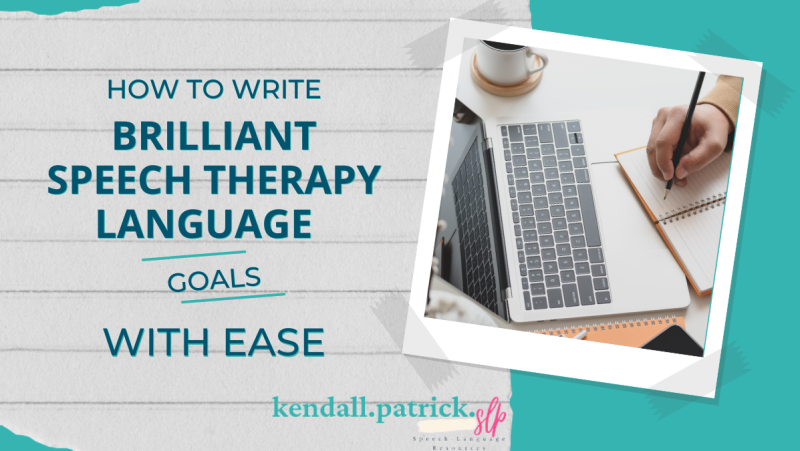Ready to learn how to write speech therapy language goals to meet all of your students’ needs? Here are all of my favorite, go-to tips for writing speech therapy goals for expressive language and speech therapy receptive language goals. I have also included a link to my Speech IEP Goal Bank to save you even more time! This bank includes speech therapy articulation goals, speech therapy language goals for kindergarten, preschool speech therapy language goals, and so much more!
To access my IEP goal bank and some of my other favorite freebies, sign up below!
Speech Therapy Goal Writing
One thing I struggled with the most when I was starting out my first year was quickly and easily writing new IEP goals or updating old goals for students on my caseload. I tended to overthink and write and rewrite my goals until they were just right for my students, making it really hard on myself. For more on my journey as a school SLP, click here.

Now 10 years in, I have created a goal bank for myself of ideas in my head and on paper that are my go-to starting points when writing an IEP. These basic goals give me a good starting point when writing my IEPs and then all I have to do is go in and individualize based on that student’s needs. Now, is absolutely everything included here? No. Will there always be outliers or students with totally different needs? Absolutely. After all, this is the schools and we just never know what each year will bring. However, we can be pretty sure we’ll need a couple of key goals in the main areas we see year after year. For me, that would be Arctic, Vocabulary, Organization, Fluency, and Comprehension.
How to Write Speech Therapy Language Goals
Goals should be written to be specific, measurable, attainable, relevant and time-based. Let’s break some of these down.
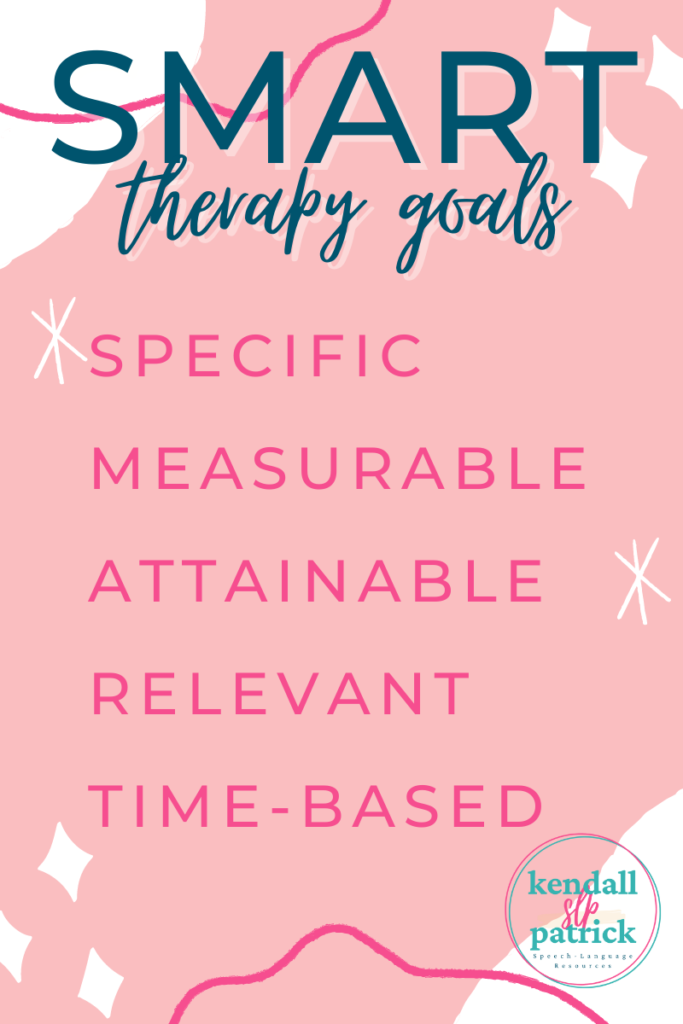
Specific – your IEP goals should be specific and define exactly what you were wanting to be accomplished. They should also specify who will accomplish it and what steps will be taken to accomplish it.
Measurable – your IEP goal should be measurable so that you can track progress and easily be able to tell when they are mastered.
Attainable – your IEP goal should be attainable. This means it’s a goal that the student can meet within a reasonable amount of time (typically within the school year or one calendar year). And remember it should be specific to the student so if that student’s accuracy is currently at 0% an attainable goal for them may be 50 to 60%, not 80.
Relevant – your IEP goal should be related to the big picture. Ask yourself what you are trying to accomplish or what you want the student to accomplish with this goal. Whether it’s gaining access to grade-level material in the classroom or building the foundational skills they need in order to gain those age-appropriate skills. Make sure it is relevant to that student’s specific means, not just based on a norm-referenced test item.
Time-based – last but not least make sure your IEP goal is time-based. Have a date and time in which the goal is expected to be mastered, whether it’s by the end of the school year, by the next grade level, or by the IEP expiration date.
Speech Therapy Expressive Language Goals
Speech therapy goals for expressive language can be tricky at times, but I’m here to share my best goal-writing and implementation tips. I find it easiest to have a few good core goals ready to go that I can then individualize depending on the student and their needs. Keeping a steady log of these goals makes IEP goal writing so much easier.
Examples:
- During structured therapy tasks, STUDENT will apply an organizational strategy to provide 3 to 4 details when defining/describing presented vocabulary as measured by therapy data and/or student product.
- STUDENT will express regular past tense verbs from pictures with 80% accuracy as measured by therapy data and observations.
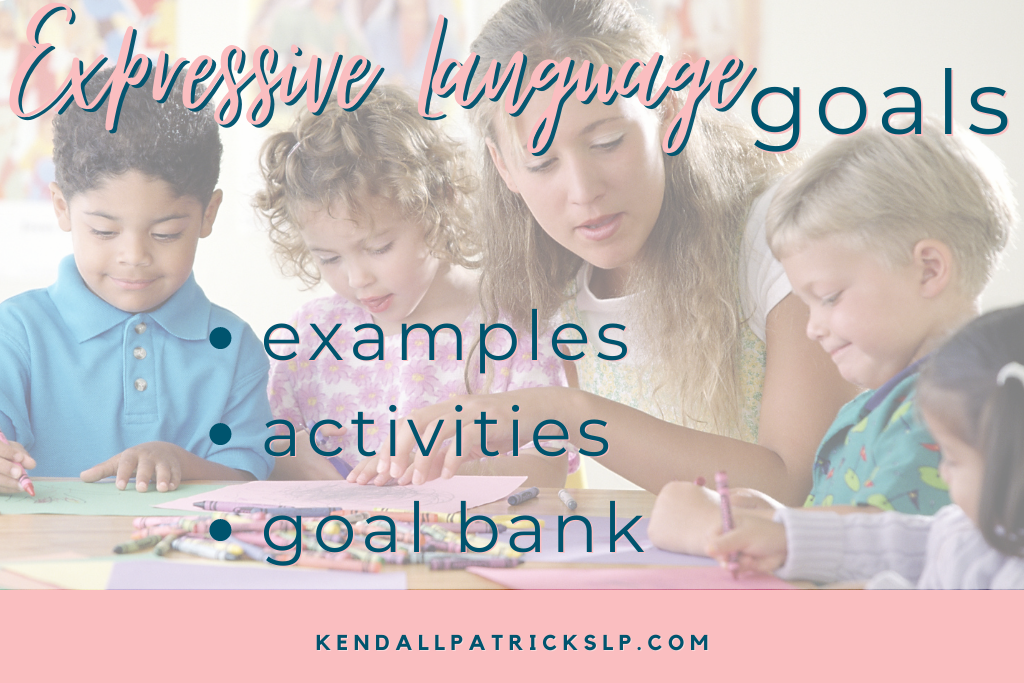
Speech Therapy Receptive Language Goals
Receptive language refers to the way our students receive and understand language (e.g., listening and reading).
Here are some examples of receptive language goals:
- During structured therapy tasks, STUDENT will identify word relationships (e.g., categories, functions, parts of a whole) through picture sorts and matching tasks with 75% accuracy as measured by therapy data.
- STUDENT will follow directions with positional concepts (e.g., under, over, in front of, behind) with 80% accuracy as measured by therapy data and observations.

More IEP Goals for Communication
Below are some example smart IEP goals that I may write for my students working on articulation, language, or fluency.
- By the end of this IEP cycle, STUDENT will ________ in structured therapy tasks with ____% accuracy with visual cues only, as measured by therapy data and observations.
- By the end of this IEP cycle, STUDENT will apply _______ strategies in structured speaking tasks (e.g., answering questions, describing, story retell) in _____ out of 5 attempts independently as measured by therapy data and observations.
- By the end of this IEP cycle, STUDENT will accurately produce the following sounds: _________ in words and phrases with 80% accuracy as measured by therapy data and observations.
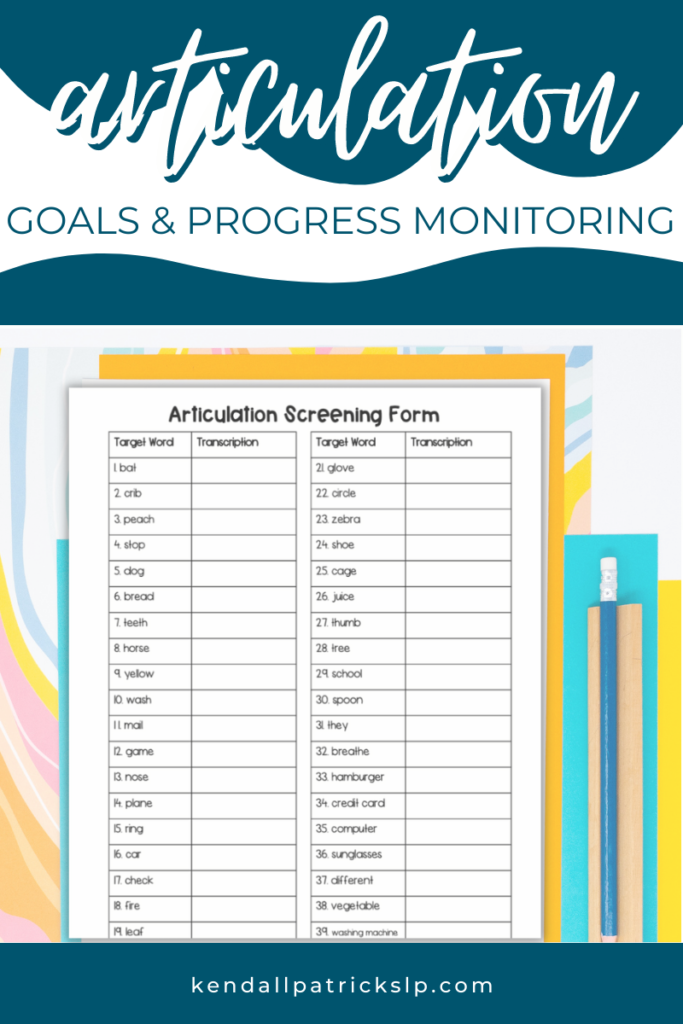
Speech Therapy Articulation Goals
Here are some examples of how I write articulation goals:
- STUDENT will accurately produce ____ sounds in isolation, words, and phrases with 90% accuracy across 3 therapy sessions as measured by therapy data and progress monitoring.
- During structured therapy tasks, STUDENT well accurately produced CVCVCV words (E.g., animal, tomato) with 80% accuracy as measured by therapy data and observation.
Progress Monitoring Speech Goals
Now, for my students with more severe articulation and/or phonological delays, that’s where it can get a little more tricky. If I were to try to go through every single sound error in every position, it would take forever. I also may not get great information about sound patterns and situations they may struggle/not struggle with – not to mention how incredibly frustrating it would be for the child. For that reason, I use a quick articulation/phonological progress monitoring tool (which also doubles as a screener) to get a snapshot of the child’s overall sound errors. It not only gives me a great place to start but also gives me a quick, visual, easy way to progress-monitor throughout the year and before IEP updates.
Speech IEP Goals Bank
A speech IEP goals bank is a great place to start when writing a new IEP, especially when you are new to the schools. While absolutely IEP goals fro speech should always be individualized, it doesn’t hurt to have a place to start. My IEP goals bank is a brief but inclusive list of a variety of goals that target various areas of speech and language therapy.
Remember, while it is great to have a goal bank in a place to start, you always have to individualize. What is right for one student may not necessarily be what’s right for another. Even when students are working on similar goals they may reach those goals in different ways and at different times. This is where you can individualize percentages, number and types of prompts needed/provided, in what situations, and with what mode of communication.
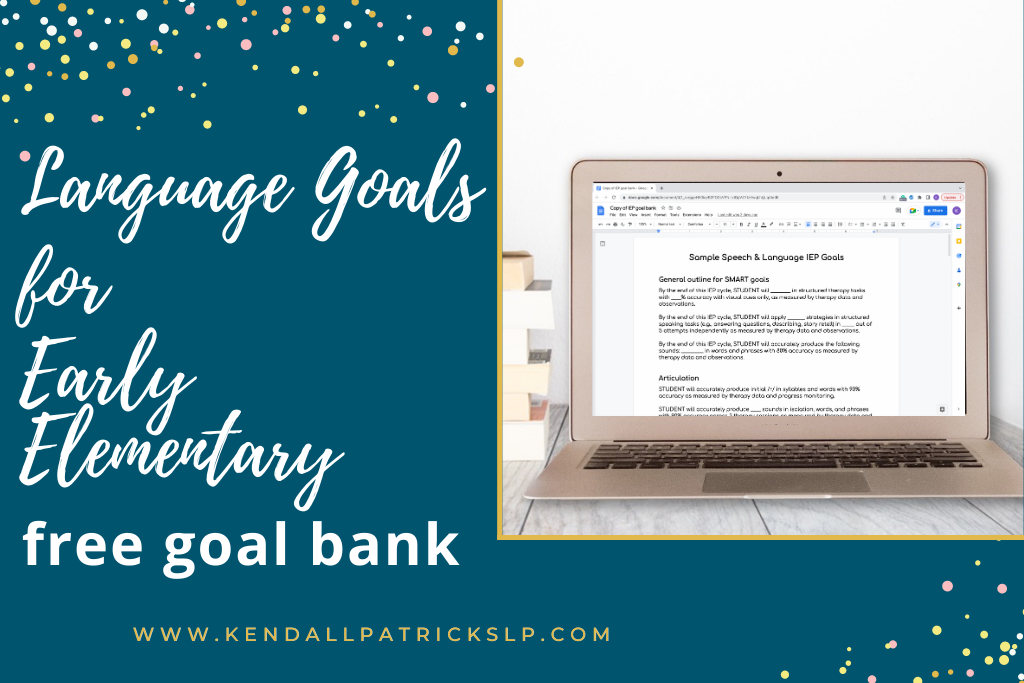
Speech Therapy Language Goals for Younger Populations
Working on story retell and vocabulary are both great ways to get the most bang for your buck in language therapy. Vocabulary knowledge helps to build the foundation for later reading and academic success. Narrative language acquisition helps promote better comprehension as well as use of complex language. When working on narrative language, you are also incorporating grammar skills, social skills, vocabulary, and comprehension all in one.
While these areas are great to work on, sometimes writing goals for them can be tricky. I’ve found it easiest to do it one of two ways:
1. Write a goal for one target you want to address within the goal
1. For example, targeting past tense verbs for grammar while working on retell
2. Or focusing on category words while learning vocabulary strategies
2. Or write the goals for the big picture you want to accomplish
1. For example, STUDENT will retell a simple episode by including 4/5 story grammar components.
2. STUDENT will apply an organizational strategy to describe/define vocabulary by providing at least 3 attributes (e.g., category, parts, function, etc.)
Speech Therapy Language Goals for Kindergarten
By Kindergarten/early elementary, children should be able to retell a simple story, answer questions about the story, AND demonstrate understanding of more components of the story- character/character description, setting, feelings, plot, etc.
At this stage, I may still work on simple word relationships if needed, but I also may move into applying vocabulary strategies to help with organization. So my goals might look like this:
STUDENT will apply an organizational strategy to express 3-4 story grammar parts (e.g., character, setting, problem, ending) following an orally presented story in 3 out of 4 attempts as measured by therapy data and progress monitoring.
During structured therapy tasks, STUDENT will apply an organizational strategy to provide 3 to 4 details when defining/describing presented vocabulary as measured by therapy data and/or student product.
Speech Therapy Language Goals for Preschool
In preschool, a child should be able to understand a simple story, as shown by answering questions about the orally presented story and retelling a simple story in sequence.
At this stage, I like to focus on simple word relationships, simple narratives, and basic comprehension (e.g., sorting items in categories, retelling a simple/single episode, answering who and what questions following a story). So my goals might look like this:
Given a sentence starter, STUDENT will express word relationships (e.g., category, parts of a whole, similarities/differences, color) with 80% accuracy.
STUDENT will accurately sequence at least 3 events from an orally presented story with 80% accuracy as measured by therapy data and observation.
Long pin preschool-speech-therapy-language-goals
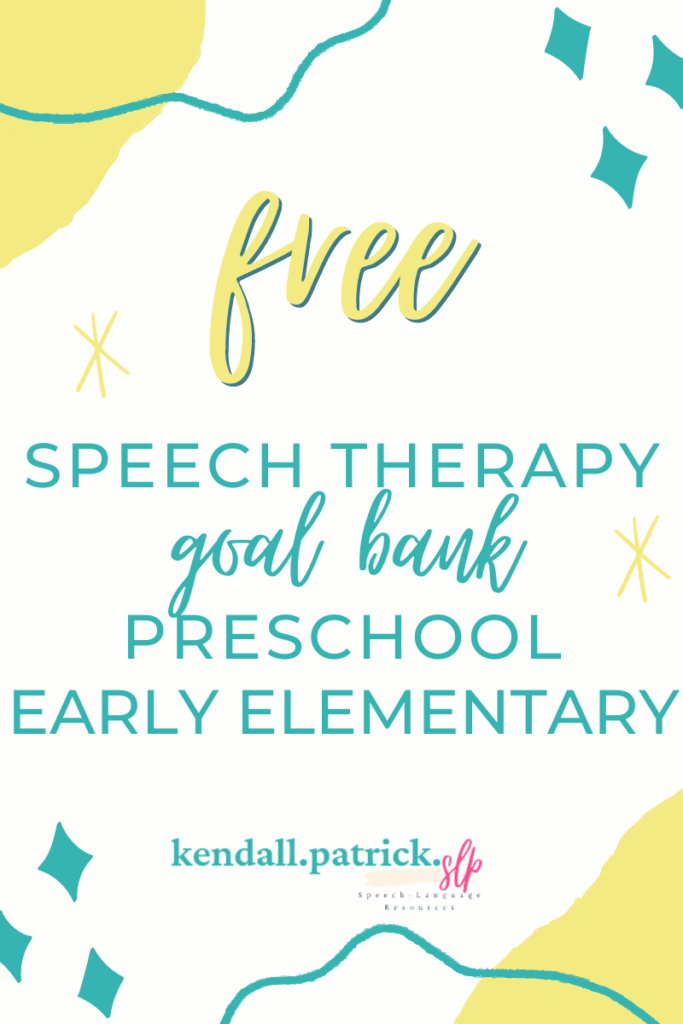
More Preschool Speech Therapy Language Goals
I love using wordless pictures books to work on describing and narrative retell. Because you are not stuck to one story line or one main character, you can work on multiple different story lines and take your therapy targets in any direction. These are some things I might target with a wordless book:
- Character description (use visual strategies and/or graphic organizers)
- Setting description (use visual strategies and/or graphic organizers)
- Sequenced events – use the pictures to guide the story, have a student make it up, generate a story together, or you tell the story and have students retell it using the pictures
- Transition words
- Feeling words – use facial features to describe how they may be feeling
- Predicting
- Drawing conclusions
For more information on speech therapy goal writing:
How to Write Expressive Language Goals [with goal bank] from Communication Community
Speech Therapy Goals for 4th and 5th Graders from The Pedi Speechie
Quick Tips for Writing Speech and Language IEP Goals from Anna Dee SLP
Don’t forget to sign up with your email address here to get access to my free library (growing all the time) full of some of my goodies made exclusively for my followers.
I hope you found some of these ideas helpful and can use one or more in your therapy room. Please leave a comment or shoot me an email if you want to share some of your favorite speech therapy language goals and treatment ideas.

